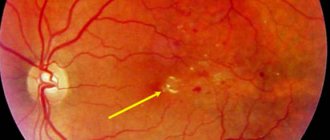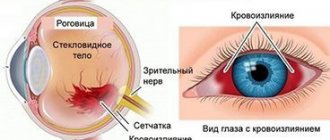Causes Symptoms Diagnostics Treatment Our advantages Treatment price
Retinal angiopathy is not an independent disease. This is a manifestation of those diseases that affect the blood vessels of the human body, including the network of blood vessels in the retina. Angiopathy manifests itself as a pathological change in blood vessels, which is caused by a violation of nervous regulation. Now more attention is being paid to this disorder, because it often leads to tragic consequences, including loss of vision. Retinal vascular angiopathy is detected in both children and adults, although it most often occurs in people over 30 years of age.
It is customary to classify this pathology according to the diseases that caused its development. Angiopathy happens:
- Diabetic. Damage to the vessels of the retina is caused by an advanced form of diabetes mellitus, in which all blood vessels in the body are affected, which leads to a significant deterioration in blood flow and blockage of blood vessels. Due to this condition, vision loss occurs;
- Hypertensive. Which can develop against the background of existing hypertension. Hypertension provokes branching of veins, their expansion, frequent pinpoint hemorrhages in the eye, and clouding of the eyeball. Successful treatment of hypertension guarantees spontaneous disappearance of aniopathy, without additional therapy;
- Hypotonic. This angiopathy is characterized by a decrease in the tone of small vessels and is accompanied by overflow of blood vessels, which also causes blood clots. One of the signs of hypotonic retinal angiopathy is the pulsation of the eye vessels felt by the patient;
- Traumatic. Such retinal angiopathy can develop with damage to the cervical spine, traumatic brain injury, or sudden significant compression of the chest. Angiopathy is caused by compression of the blood vessels of the cervical spine or increased intracranial pressure;
- Youthful. This is the most unfavorable type of angiopathy, the causes of which have not yet been fully investigated. Its most common manifestations are: inflammation of blood vessels, hemorrhages that can occur in the retina or vitreous body. Often there is an overgrowth of connective tissue on the surface of the retina, leading to cataracts, glaucoma, retinal detachment and blindness.
Diagnostics
The disease is diagnosed by an ophthalmologist based on symptoms and after a general examination of the patient. In order to clarify the diagnosis, studies are prescribed, including ultrasound scanning of blood vessels, which provides information on the speed of blood circulation, as well as the condition of the walls of blood vessels, or X-ray examination, which is carried out using a contrast agent, to inspect the patency of blood vessels. Sometimes magnetic resonance imaging may be needed, which allows you to determine the structure of soft tissues and their condition.
Stages of development of diabetic angiopathy disease
There are several types of diabetic angiopathy. She may be:
Non-proliferative. The vessels in the fundus are gradually affected, microscopic aneurysms form, and small hemorrhages develop. At this stage, the retina swells and the iris becomes redder.
Preproliferative. The retinal veins are damaged. Rupture of the vessel causes hemorrhage and the formation of venous infiltrate, which causes significant visual impairment.
Proliferative. It is the most difficult stage. New capillaries are formed, which are fragile. As a result, multiple hemorrhages appear, which cause retinal detachment.
Traumatic. If the head, neck or eyes are injured, blood vessels are compressed and intracranial pressure increases. As a result, leukocyte emboli are formed.
Youthful. It is a rare and dangerous form of the disease. The etiology is not fully understood. The development of pathology is observed before the age of 25 years. The manifestation of juvenile angiodystonia is the inflammatory process, hemorrhage, and proliferation of connective tissues. As a result, various complications arise.
Congenital. In most cases, premature babies suffer from this form of the disease due to the fact that their vascular system is underdeveloped.
To make the most accurate diagnosis and begin appropriate treatment, it is necessary to determine the type of retinal angiopathy. Treatment measures should begin when the initial stage is present. Without adequate treatment, the patient may go blind.
Treatment
Understanding that retinal angiopathy is a consequence of a systemic disease, to treat it, it is necessary to eliminate the underlying pathology. With hypertensive angiopathy, the leading role in treatment belongs to normalizing blood pressure and reducing blood cholesterol levels. To treat diabetic angiopathy, in addition to previously prescribed glucose-lowering drugs, a mandatory special diet is added, which excludes foods high in carbohydrates from the diet. Moderate physical activity is also useful, as it can support the functioning of the heart and blood vessels.
To alleviate the condition of the blood vessels of the eyes, drugs that normalize blood circulation are indicated: pentilin, trental, vasonite, solcoseryl, arbiflex, emoxipine, etc. The listed drugs improve the bendability of red blood cells, which ensures activation of blood flow in the capillaries. Patients with fragile blood vessels are recommended to take calcium dobesilate. This drug thins the blood, improves its circulation in the vessels, and normalizes the permeability of the vascular walls.
Treatment of retinal angiopathy involves the use of physiotherapeutic methods: magnetic therapy, acupuncture and laser exposure. These procedures can improve the general condition of the patient.
Retinal angiopathy is a reversible side condition that many are not inclined to take seriously. And yet, in an advanced form without adequate treatment of the underlying disease, it leads to severe deterioration of vision or even its complete loss.
Why does angiopathy appear?
There are some diseases that cause the development of such ophthalmological pathology. This means the presence of:
- Diabetes mellitus.
- Hypertension.
- Atherosclerosis.
- Rheumatism.
- Disorders of the thyroid gland.
- Autoimmune vasculitis.
- Anemia.
- Leukemia.
- High intracranial pressure.
- Cervical osteochondrosis.
- Scoliosis.
In addition, retinal angiopathy is a consequence of diseases of the central nervous system, in which vascular tone is impaired, and congenital heart disease. Also, retinal angiopathy can be provoked by excess body weight, smoking, if production activities involve harmful substances, and long-term use of medications that contribute to impaired vascular tone.
Angiopathy can occur due to the penetration of toxins into the body, due to the fact that a person lives in a place where there is a high level of radiation. Another reason for the occurrence of the disease is the presence of a genetic predisposition. The risk zone includes people over 65 years of age and pregnant women.
Our advantages
"Moscow Eye Clinic" offers comprehensive diagnostics and effective treatment of eye diseases. The use of modern equipment and the experience of specialists working in the clinic eliminate diagnostic errors.
Based on the results of the examination, each visitor will be given recommendations on choosing the most effective methods of treating the eye pathologies identified in them.
The high level of theoretical training and practical experience of our doctors guarantees the achievement of good treatment.
Author:
Mironova Irina Sergeevna 5/5 (1 rating)
Honey. portal:
Types of disease
The pathological condition of the body, when the blood supply to the fundus of the eye deteriorates, becomes the main cause of the development of retinal angiopathy. Capillaries in the visual apparatus can change regardless of age, but are often diagnosed in elderly patients. Considering the nature of the origin, retinal angiopathy can be:
- Hypertensive. Hypertensive angioneuropathy develops due to high blood pressure. As a result of arterial hypertension, the central artery is damaged, blood vessels narrow, veins dilate, and retinal tissue is affected. Branching of the venous bed occurs, pinpoint hemorrhage occurs, and atherosclerosis may develop. If treatment for hypertension is started in a timely manner, there is a high probability of the eye structure returning to normal.
- Hypotonic. Due to low blood pressure, blood flow slows down, the tone of small capillaries decreases, so the blood thickens and blood clots begin to form. At the diagnostic stage, it can be determined that the arterial network has expanded and the veins are pulsating.
- Diabetic. Diabetes mellitus causes damage to all blood vessels, resulting in poor circulation, blockage of blood vessels, swelling of the capillary wall and deterioration of visual function. High glucose levels provoke the formation of blood clots, tissue atrophy, and multiple hemorrhages.
What happens to the retina?
During an ophthalmological examination, hypotonic retinal angiopathy has no clear signs. The arterial branches of the vessels are clearly visualized down to the smallest branches. However, upon examination, their pallor and opacity are revealed. There is practically no double contour; due to a decrease in the tone of the vascular wall, the vessels become tortuous.
It is known that the diameter of the arteries is normally larger than the diameter of the veins, but with hypotensive angiopathy their caliber becomes the same. The veins are filled with blood and their pulsation is detected. Due to prolonged standing of blood, tissue swelling develops, which creates conditions for thrombus formation.
As a rule, changes in the retina are dystrophies, small opacities along the main vessels, and vein thrombosis. But, in the case of prolonged hypotension, the opposite effect often occurs - hypertensive angiopathy develops due to deposits of lipids and calcium in dilated vessels. This leads to a loss of elasticity of the vascular wall, which loses the ability to change diameter.
Symptoms of the disease in children
Among the symptoms of angiopathy, one should distinguish subjective signs that the child himself can feel and describe, and objective ones that can be seen from the outside.
The first group of symptoms include:
- Glare, streaks and colored spots before the eyes.
- Loss of visual acuity.
- Nosebleeds.
- Erroneous determination of the shape and outline of objects located at an average distance.
- Itching in the eyes and a constant desire to scratch them.
Objective visual signs include blood in the urine, redness of the conjunctiva and slight swelling of the eyelids.
Laser coagulation of the retina
| Name of procedure | Price |
| Laser coagulation for peripheral retinal degeneration (RPD) | 3,500 UAH. |
| Laser coagulation for peripheral retinal degeneration (complicated option, indications are determined by a retinologist) | 3,800 UAH. |
| Laser coagulation for diabetic retinopathy (DRP), thrombosis, central serous retinopathy and other vascular abnormalities, first session | 3,200 UAH. |
| Laser coagulation for diabetic retinopathy (DRP), thrombosis, central serous retinopathy and other vascular abnormalities, subsequent sessions | 2,000 UAH. |
| Laser coagulation of the “Grid” type, for macular pathology (lacerations, cystoid macular edema, etc.) | 3,000 UAH. |
| YAG laser dissection of secondary membranous cataracts, pupillary films, iridotomy, schwartotomy in the anterior and middle third of the vitreous body using the Ellex SuperQ YAG laser | 3,800 UAH. |
| Selective laser tubeculoplasty (SLT) for open-angle glaucoma | 3,500 UAH. |
| Additional peripheral laser coagulation procedure (small volume up to 200 pulses) | 1,800 UAH |
| Panretinal laser coagulation | 4000 UAH |
The price is for treatment of one eye.
SIGN UP FOR VISION DIAGNOSTICS
Pediatric retinal angiopathy
Complicated childbirth can cause the development of hypertensive angiodystonia of retinal vessels in a newborn child. Also, a provoking factor is birth trauma or impaired intrauterine development of the baby. In addition, there are a number of factors that can cause the development of a pathological condition in a child:
1. The woman did not eat properly while pregnant.
2. Presence of genetic predisposition.
3. Congenital defect of the cardiovascular system.
4. Premature delivery.
5. Hypoxia.
6. The cervical spine was damaged during childbirth.
If the newborn is given timely and correct therapy, the disease disappears within 8-10 weeks. If signs of angioneuropathy appear, you should immediately consult a specialized doctor. Such a disease may indicate the development of diabetes mellitus, glomerulonephritis, renal retinopathy, and impaired blood pressure.
At an older age, the development of childhood angiopathy is the cause of an infectious disease, vegetative-vascular dystonia, impaired material metabolism, and vascular pathology.
Cost of treatment at the Santa Clinic
The price for treatment of angiopathy is determined depending on the chosen method of therapy. The exact cost can be found out after receiving the results of the analysis and examination by an ophthalmologist.
The Santa Clinic practices various methods of treating angiopathy. Experienced surgeons successfully perform laser coagulation operations. Previously, the patient is completely examined using hardware techniques. If concomitant pathologies are identified, consultation with specialists will be required.
To make an appointment please call. Operators will choose a convenient time for you to visit.
Development of angiopathy during pregnancy
This is a common phenomenon that occurs in both new and experienced mothers during the second or third semester. In most cases, the disease appears towards the end of pregnancy.
The appearance of retinal angiodystonia is associated with high blood pressure, atherosclerosis or diabetes mellitus. As the embryo grows, blood volume increases, pressure jumps (especially in a stressful situation), which causes the vascular walls to stretch. As a result, the risk of thrombosis, hemorrhage, retinal detachment, and blindness increases.
It is worth highlighting the characteristic differences of hypertensive angiopathy during pregnancy:
- Periodic narrowing of the arteries. The cause is toxicosis.
- Sclerosis of blood vessels.
- Impaired blood circulation.
- The visual system recovers quickly after the birth of a child.
If such a pathological condition develops during pregnancy, the doctor may prescribe a planned cesarean section. Natural childbirth can cause retinal vessels to rupture, and a woman can completely lose her vision.
Causes
The main factor in bilateral damage to the microvasculature of the eyes is vascular anomaly, as well as large-scale chronic diseases of the cardiovascular system. Among young patients with this diagnosis, patients with endocrine pathologies predominate:
- diabetes mellitus;
- adrenal dysfunction;
- over or underactive pituitary gland.
Good to know! Of these diseases, diabetic angiopathy is considered the most common.
Among older patients, the disease most often develops against the background of cardiovascular pathologies:
- hypertension;
- atherosclerosis of head vessels;
- vascular obstruction due to thrombocytopenia, thrombosis, thromboembolism;
- autoimmune vascular inflammation;
- chronic heart diseases, including coronary artery disease and heart failure;
- acute heart diseases, including angina pectoris and myocardial infarction.
According to the observation of ophthalmologists, retinal angiopathy can be provoked by disorders of the musculoskeletal system, accompanied by pinching of nerves and blood vessels in the neck and upper spine. Bad habits, working with toxic volatile solutions and environmental pollution negatively affect the condition of the eye capillaries.










